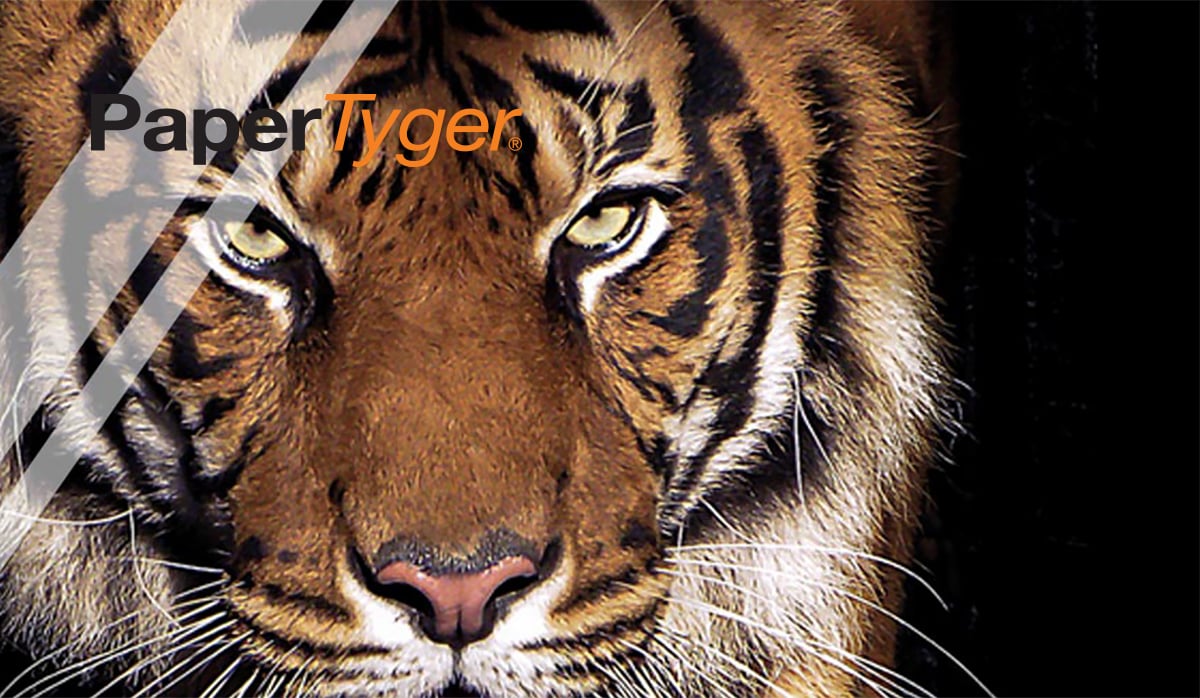There's a myth that all printer-compatible papers are the same. This couldn't be further from the...
PaperTyger Converting and Finishing Tips
 PaperTyger durable papers perform well with guillotining, slitting, die-cutting, hole punching, drilling, perforating, folding, gluing, bonding, sewing, grommeting, foil stamp or embossing.
PaperTyger durable papers perform well with guillotining, slitting, die-cutting, hole punching, drilling, perforating, folding, gluing, bonding, sewing, grommeting, foil stamp or embossing.
Guillotine Trimming
When trimming on a guillotine, a sharp blade is required. PaperTyger will trim as comparable papers would. Fanning of the cut edge of the stack is usually sufficient to break edge fusion.
Slitting
Shear slitting with sharp blades, close tolerance to the blade, and good alignment is recommended to produce smooth edges and minimise dust. Score slitting is also an acceptable means of slitting PaperTyger but will not produce as clean an edge as shear slitting. Razor slitting of PaperTyger substrate is not recommended because it creates dust and fibres on cut edges and does not leave a clean sharp edge.
Recommended processing tensions of PaperTyger laminates vary from 1.5 to 2 pounds per linear (PLI) for the thinner substrates to 2.5 to 3 PLI for the thicker substrates. So, for every inch of width in the master roll, 1.5 to 2 pounds of tension needs to be used. For example, a 50-inch roll would run between 75# (50*1.5) to 100 # (50*2) of tension.
Die Cutting

Several types of die-cutting have been demonstrated with Paper Tyger: steel rule dies, forged or "high" dies, rotary dies, and blanking dies. These require sharp cutting edges to produce clean cuts in PaperTyger; because plastics do not burst like paper PaperTyger must be completely penetrated. Rotary die cutting PaperTyger is comparable to paper with no measurable wear to the die blade. Blanking die cuts are typically used on PaperTyger and die cuts comparable to Paper.
Hole Punching / Drilling
Use sharp dies, tight male/female tolerances will improve punching performance.
When drilling holes in PaperTyger
- Using sharp drill bits with drill wax and a rapid delivery
- Drilling in short lifts with a wax paper or carbon paper on top of the lifts to lubricate the drill bit
Line hole punching can be done using sharp, hardened dies.
Perforation
PaperTyger’s tear resistance is greater in the cross direction (CD). Microperfing will provide approximately equal tear in both directions. Sharp perforation wheels and bars will provide the cleanest job. A litho perforation is also a form of Perforation used on PaperTyger.
Folding
PaperTyger folds well in either direction. Scoring is recommended to obtain a tight fold on PaperTyger. The grain direction of PaperTyger is similar to that of paper; therefore, the direction can affect the tear characteristic of the sheet. The best way to determine the optimum configuration of a fold in design is to test the effect of the sheet direction on the final product. For optimum fold performance, the machine direction of Paper Tyger substrate should be oriented perpendicular to the direction of the fold line.
Gluing and Bonding
There are several end-uses which require gluing or bonding of PaperTyger hot melt adhesives water-based glues and adhesives can be used and will bond as comparable paper would. PaperTyger will also accept latex.
Sewing and Grommeting
In general, PaperTyger fabricates much like film and should be handled as such.
Foil Stamping
When properly applied, foil can adhere to PaperTyger as comparable papers would. Temperatures in the range of 200 - 240 F may be required. The temperature setting will be a function of the foil, the pattern and the hardware. It is recommended that some experimental work be conducted to determine the best set of conditions for the contemplated design.
Embossing
With a male and female die system, PaperTyger will emboss similar to comparable papers. The effects of embossing will be most pronounced with thicker grades of PaperTyger. Cold embossing is generally comparable to paper. Dwell times and pressure requirements will be a function of the graphics, the degree of embossing desired, and the hardware.
For more information about PaperTyger converting and finishing tips, please contact one of our paper experts! If you have custom requirements, we are happy to work with you directly to create a perfect solution.






